States and Capitals
States and Capitals: India is a vast country having 28 states and 8 union territories and is known as the most populous country in the world. In terms of area, India comes 7th in the world and has a rich culture across the country. Each state has its capital city its importance, identity, and history. India falls in the Asian continent specifically in southern Asia and is governed by the parliamentary form of government. Each state has its administrative, legislative, and judicial capital, and in some states, all three functions are carried out in the same capital city.
The head of state is the governor and lieutenant governor in union territories. The states of India were reorganized in 1956 on a linguistic basis. This means that each state is predominantly inhabited by people who speak the same language. The below article covers all the Indian states, their capitals along with the Union territories of India and their capitals.
States and Capitals of India
India is a union of states and in the states, the Governor, as the representative of the President, is the head of the Executive. The system of state government closely resembles that of the Union. The boundaries of Indian states are reorganized on a linguistic basis by the States Reorganization Act, of 1956. Union Territories are administered by the President through an Administrator appointed by him/her. Each State/UT of India has its unique demography, history and culture, language, dress, festivals, etc. This article will answer all your questions and clear all your doubts related to the states and capitals of India.
Indian States And Capitals
The list below has all the Indian States and capitals along with their establishment year that every Indian must know:
| Serial No. | State Name | Capital | Establishment Date |
|---|---|---|---|
| 1 | Andhra Pradesh | Amaravati | 1 November 1956 |
| 2 | Arunachal Pradesh | Itanagar | 20 February 1987 |
| 3 | Assam | Dispur | 26 January 1950 |
| 4 | Bihar | Patna | 26 January 1950 |
| 5 | Chhattisgarh | Raipur | 1 November 2000 |
| 6 | Goa | Panaji | 30 May 1987 |
| 7 | Gujarat | Gandhinagar | 1 May 1960 |
| 8 | Haryana | Chandigarh | 1 November 1966 |
| 9 | Himachal Pradesh | Shimla | 25 January 1971 |
| 10 | Jharkhand | Ranchi | 15 November 2000 |
| 11 | Karnataka | Bengaluru (Formerly Bangalore) | 1 November 1956 |
| 12 | Kerala | Thiruvananthapuram | 1 November 1956 |
| 13 | Madhya Pradesh | Bhopal | 1 November 1956 |
| 14 | Maharashtra | Mumbai | 1 May 1960 |
| 15 | Manipur | Imphal | 21 January 1972 |
| 16 | Meghalaya | Shillong | 21 January 1972 |
| 17 | Mizoram | Aizawl | 20 February 1987 |
| 18 | Nagaland | Kohima | 1 December 1963 |
| 19 | Odisha | Bhubaneswar | 26 January 1950 |
| 20 | Punjab | Chandigarh | 1 November 1956 |
| 21 | Rajasthan | Jaipur | 1 November 1956 |
| 22 | Sikkim | Gangtok | 16 May 1975 |
| 23 | Tamil Nadu | Chennai | 26 January 1950 |
| 24 | Telangana | Hyderabad | 2 June 2014 |
| 25 | Tripura | Agartala | 21 January 1972 |
| 26 | Uttar Pradesh | Lucknow | 26 January 1950 |
| 27 | Uttarakhand | Dehradun (Winter)
Gairsain (Summer) |
9 November 2000 |
| 28 | West Bengal | Kolkata | 1 November 1956 |
States And Capitals Map
As of January 2023, there is a total of 28 states in India and 8 Union Territories. Union Territories are administered by the President through the administrators that are appointed. The Hon’ble President of India is the constitutional head of the Executive of the Union. Each state has its chief minister formulating the policies required to run the state.
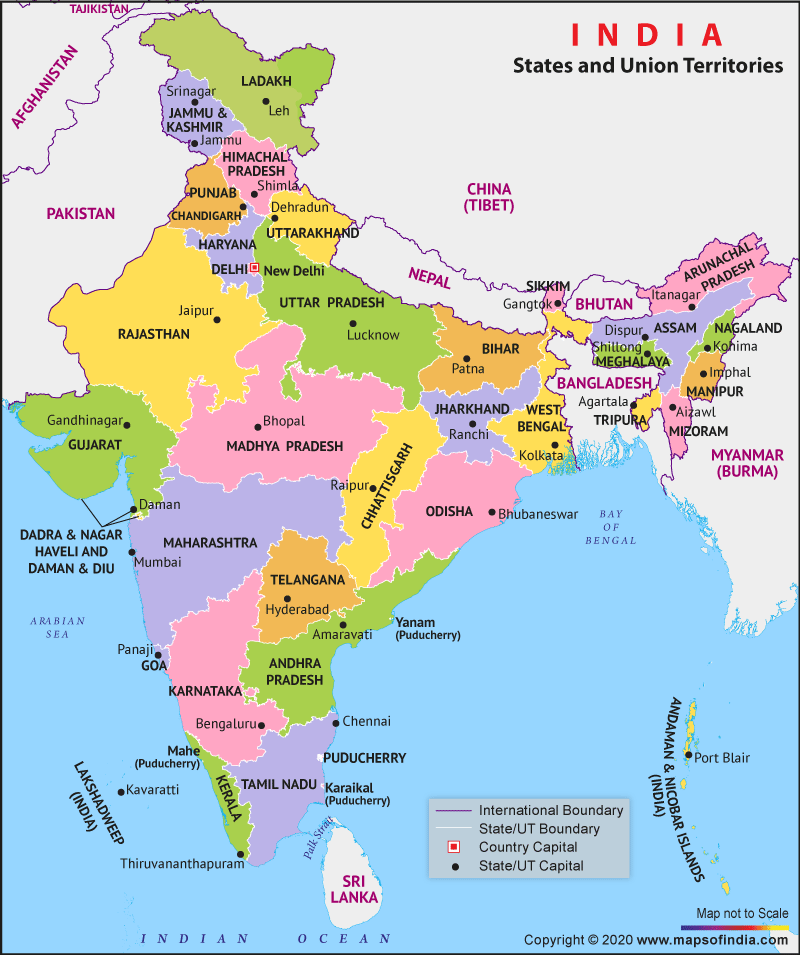
What Is A State?
Each state of India has an administrative, legislative, and judicial capital some states all three functions are conducted in one capital. It is a territory that has its own Chief Minister. A state has its separate government. Functions of the state are handled by the State Government such as security, healthcare, governance, revenue generation, etc.
What Is A Union Territory?
A Union Territory is an administrative division that is directly controlled by the Central Government. Union Territories are ruled directly by the Central Government and have a Lieutenant Governor as an administrator, who is the representative of the President of India and is appointed by the Central government.
Note: Delhi, Puducherry, and Jammu & Kashmir do not operate in the same manner as the other five Union Territories of India since they have partial statehood status and have their own elected legislative assemblies.
8 Union Territories of India
There are a total of 8 Union territories of India. Here is the list of Union Territories of India and their capitals and their establishment year:
| Union Territory | Capital | Establishment Date |
|---|---|---|
| Andaman and Nicobar Islands | Port Blair | 1 November 1956 |
| Chandigarh | Chandigarh | 1 November 1966 |
| Dadra and Nagar Haveli and Daman and Diu | Daman | 26 January 2020 |
| Delhi (National Capital Territory of Delhi) | New Delhi | 9 May 1905 |
| Lakshadweep | Kavaratti | 1 November 1956 |
| Puducherry | Puducherry (Pondicherry) | 1 November 1954 |
| Ladakh | Leh | 31 October 2019 |
| Jammu and Kashmir | Srinagar (Summer) Jammu (Winter) |
31 October 2019 |
Difference Between State and Union Territories
The differences between State and Union Territories are as follows:
| State | Union Territories |
| The state has its administrative units with its own elected government. | Union Territories are constituent units that are controlled and administered by the Central Government. |
| The Executive Head is the Governor | The Executive Head is the President |
| The relationship with the Centre is Federal. | Unitary with the Centre. i.e. all the powers rest in the hands of the Union. |
| Administered by the Chief Minister and elected by the people. | Administered by the Administrator which is appointed by the President. ( except Delhi, Puducherry, and Jammu & Kashmir) |
| Chief Minister is the real head. | The Lieutenant is the real head. |
History of States and Capitals of India
India is a sovereign, secular, democratic, republican country with a parliamentary system of government. India gained its independence on 15th August 1947. It is a land of rich cultural heritage and natural beauty. The states and Capitals of India are the basis of its linguistic, cultural, and geographical demarcation. Every state and union territory in India has an administrative, legislative, and judicial capital of its own. After independence, it comprised 2 political units namely the British Provinces and the Princely States. The partition between India and Pakistan gave three options to the princely states:
- Joining India
- Joining Pakistan
- Remaining independent
Out of the 552 princely states situated within India, 549 joined India and the remaining 3 refused to join India. However, they also integrated later. The Constitution of India was adopted on 26 November 1949 and it was implemented on 26 January 1950. The boundaries of the states of India are reorganized on a linguistic basis by the States Reorganization Act, of 1956.
Indian States and Capitals: UT Updates
Check out the recent updates on UTs as of July 2020.
-
Since 26th January 2020, India has had 8 union territories. The U.T Daman and Diu, Dadra, and Nagar Haveli have become a single union territory.
- On August 5, the central government also announced the abrogation of the special status given to Jammu and Kashmir under Article 370 and its division into two Union Territories i.e. UTs of Jammu and Kashmir, and Ladakh.
-
With the merger of Daman and Diu, and Dadra and Nagar Haveli, the number of UUT shave come down to eight.
States and Capitals of India: Articles in the Constitution
Articles 1 to 4 under Part 1 of the Constitution describe India and its territories.
- Article 1 describes India as the “Union of States” and not the “Federation of States” The names of states and their territories are mentioned in the first schedule of the constitution.
- Article 2 permits the parliament to ‘admit into the Union of India or establish new states on such terms as it thinks fit.’ Hence, it gives power to parliament to establish new states.
- Article 3 authorizes the parliament to-
a) form a new state by separation of territory
b) increase the area of the state
c) diminish the area of any state
d) alter the boundary of any state
e) alter the name of any state
List of the Indian States and their CMs and Governors
The candidates preparing for any government exam must know all the Chief Minister and Governor of Indian states. Not only aspiring candidates but also every Indian citizen must have the following knowledge about the country. Check the below table for the list of the Indian States and their CMs and Governors:
| State | Chief Minister | Governor |
|---|---|---|
| Andhra Pradesh | Sri Nara Chandrababu Naidu | S. Abdul Nazeer |
| Arunachal Pradesh | Shri Pema Khandu | Lieutenant General Kavalya Trivikram Paraneek, PVSM, UYSM, AVSM, YSM (Retd.) |
| Assam | Shri Himanta Biswa Sarma | Shri Gulab Chand Kataria |
| Bihar | Shri Nitish Kumar | Shri Rajendra Vishwanath Arlekar |
| Chhattisgarh | Vishnu Deo Sai | Shri Biswa Bhushan Harichandan |
| Delhi (National Capital Territory of Delhi) | Atishi Marlena Singh | Shri Vinay Kumar Saxena (Lieutenant Governor) |
| Goa | Shri Pramod Sawant | Shri P.S. Sreedharan Pillai |
| Gujarat | Shri Bhupendra Patel | Shri Acharya Dev Vrat |
| Haryana | Nayab Singh Saini | Shri Bandaru Dattatraya |
| Himachal Pradesh | Sukhvinder Singh Sukhu | Shri Shiv Pratap Shukla |
| Jharkhand | Shri Hemant Soren | Shri C.P. Radhakrishnan |
| Karnataka | Shri Siddaramaiah | Shri Thawar Chand Gehlot |
| Kerala | Shri Pinarayi Vijayan | Shri Arif Mohammed Khan |
| Madhya Pradesh | Mohan Yadav | Shri Mangubhai Chhaganbhai Patel |
| Maharashtra | Shri Eknath Shinde | Shri Ramesh Bais |
| Manipur | Shri N. Biren Singh | Smt. Anusuiya Uikey |
| Meghalaya | Shri Conrad Sangma | Shri Fagu Chauhan |
| Mizoram | Lalduhoma | Kambhampati Haribabu |
| Nagaland | Shri Neiphiu Rio | La. Ganesan |
| Odisha | Shri Naveen Patnaik | Raghubar Das |
| Puducherry (UT) | Shri N. Rangaswamy | Dr. Tamilisai Soundararajan (Lieutenant Governor) |
| Punjab | Shri Bhagwant Mann | Shri Banwarilal Purohit |
| Rajasthan | Bhajan Lal Sharma | Shri Kalraj Mishra |
| Sikkim | Shri Prem Singh Golay | Shri Lakshmi Prasad Acharya |
| Tamil Nadu | Shri M.K. Stalin | Shri R.N. Ravi |
| Telangana | Anumula Revanth Reddy | C. P. Radhakrishnan |
| Tripura | Dr. Manik Saha | N. Indrasena Reddy |
| Uttar Pradesh | Shri Yogi Adityanath | Shrimati Anandiben Patel |
| Uttarakhand | Shri Pushkar Singh Dhami | Lieutenant General Gurmeet Singh, PVSM, UYSM, AVSM, VSM (Retd.) |
| West Bengal | Smt. Mamata Banerjee | Dr. CV Anand Bose |
List of Union Territory with their Governors
Check the table below to know the Governors of the Union Territories of India.
| Union Territory | Governor |
| Andaman & Nicobar | Admiral Devendra Kumar Joshi (Lieutenant Governor) |
| Chandigarh | Banwarilal Purohit (Administrator) |
| Dadra and Nagar Haveli and Daman and Diu | Praful Khodabhai Patel(Administrator) |
| Delhi (National Capital Territory of Delhi) |
Vinai Kumar Saxena (Lieutenant Governor) |
| Jammu and Kashmir | Shri Manoj Sinha (Lieutenant Governor) |
| Lakshadweep | Shri Praful Patel (Administrator) |
| Puducherry |
C. P. Radhakrishnan (Lieutenant Governor) Chief Minister: N. Rangaswamy |
| Ladakh | B.D. Mishra |
List of the Indian States and their Languages
India is known for its culture and different languages in one country and this diversity is very well carried by Indian citizens. The below table has all the languages that are spoken in each state
| S.No. | States | Language |
| 1 | Andhra Pradesh | Telugu and Urdu |
| 2 | Arunachal Pradesh | Miji, Apotanji, Merdukpen, Tagin, Adi, Honpa, Banging-Nishi |
| 3 | Assam | Assamese |
| 4 | Bihar | Hindi |
| 5 | Chattisgarh | Hindi |
| 6 | Goa | Marathi Konkani |
| 7 | Gujarat | Gujarati |
| 8 | Haryana | Hindi |
| 9 | Himachal Pradesh | Hindi and Pahari |
| 10 | Mizoram | Mizo and English |
| 11 | Jharkhand | Hindi |
| 12 | Karnataka | Kannada |
| 13 | Kerala | Malayalam |
| 14 | Madhya Pradesh | Hindi |
| 15 | Maharashtra | Marathi |
| 16 | Manipur | Manipuri |
| 17 | Meghalaya | Khashi, Jaintia, And Garo |
| 18 | Nagaland | Ao, Konyak, Angami, Sema, and Lotha |
| 19 | Odisha | Oriya |
| 20 | Punjab | Punjabi |
| 21 | Rajasthan | Rajasthani and Hindi |
| 22 | Sikkim | Bhutia, Hindi, Nepali, Lepcha, Limbu |
| 23 | Tamil Nadu | Tamil |
| 24 | Tripura | Bengali, Tripuri, Manipuri, Kakborak |
| 25 | Telangana | Telugu |
| 26 | Uttar Pradesh | Hindi |
| 27 | Uttarakhand | Hindi |
| 28 | West Bengal | Bengali |
| Other Related Articles | |
| Largest State in India | Dams in India |
| List of Prime Ministers of India | Union Territories of India |
| National Symbols of India | President Salary in India |

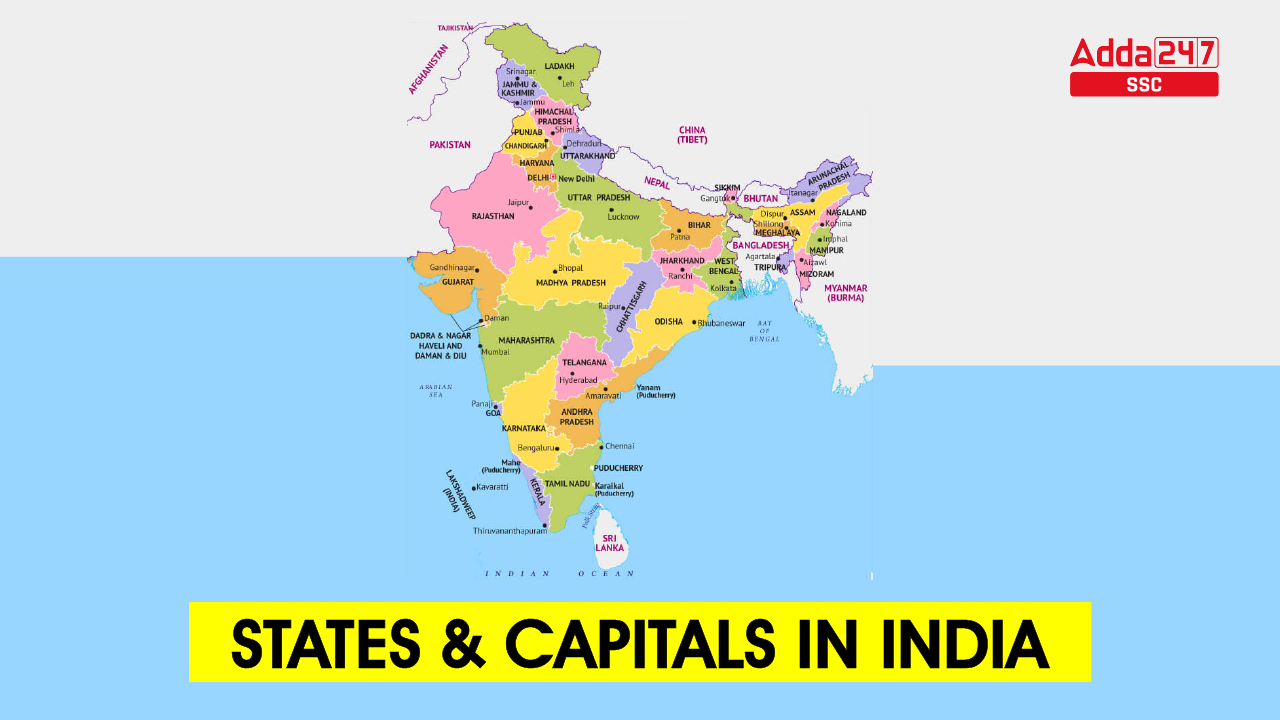


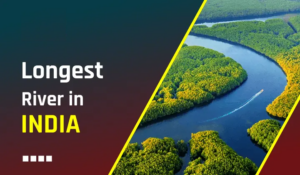 Top 10 Longest Rivers in India, Largest ...
Top 10 Longest Rivers in India, Largest ...
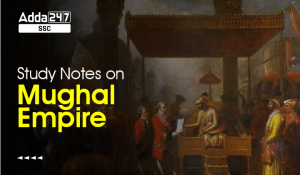 Mughal Empire Notes For RRB NTPC Exam 20...
Mughal Empire Notes For RRB NTPC Exam 20...
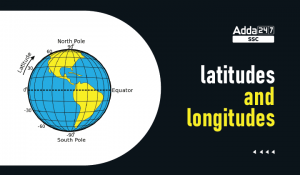 Longitude and Latitude of India - Defini...
Longitude and Latitude of India - Defini...


